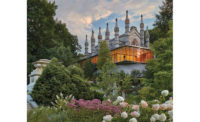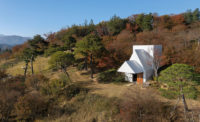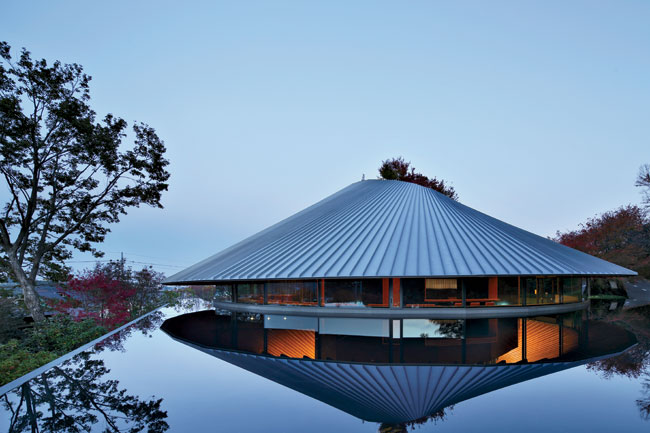Sayama Lakeside Cemetery Park Community Hall and Forest Chapel
A Separate Peace: Two bold yet thoughtful structures elevate the architecture of grieving and remembrance at burial grounds near Tokyo.


























































Architects & Firms
Saitama, Japan
Contemporary religious facilities in Japan rarely draw architectural pilgrims. But Hiroshi Nakamura's Sayama Lakeside Cemetery Park Community Hall and Forest Chapel are two buildings that could change that. From their dramatic roofs down to their exquisite details, each one addresses the delicate subject of death with remarkable sensitivity and grace. Located in the Tokyo suburb of Sayama, both were constructed in honor of the burial center's 40th anniversary. Keen to replace their original but outdated buildings, cemetery officials held a competition for the Community Hall and awarded the commission to Nakamura. Delighted with the architect's scheme, they invited him to recreate the chapel too.
Designated as a place for visitors to rest, the building's outer ring begins with a lounge and then widens to accommodate four semiprivate dining rooms, followed by an outdoor preparation area for ritual gravestone washing, a custom performed in the cemetery itself. Serving as the cemetery's administrative hub, the core houses offices and a pantry. It also contains a reception area, public washrooms and a flower shop located near the entrance for visitor convenience. Planted on top of the core is a cluster of maple trees visible through a clerestory window and encircled by the building's doughnut-shaped roof.
One of the building's most dramatic features, the roof has a dynamic form that follows the interior spatial flow. Ushering the bereaved inside, it rises up steadily from the foyer, reaching its apex at the end of the lounge. From there, it swoops back down over the dining area before completing its circuit at the entrance.
Supported by rings of slender steel columns, one at the outer wall and the other above the reinforced-concrete core, the roof is held up by 120 wood beams. Fanning out from above the core, they vary incrementally in length and angle to accommodate the building's irregular footprint. The beams culminate in extra-long eaves that hover over the pool, their undersides animated by the reflection of the rippling water. 'A special characteristic of [traditional] Japanese architecture is that it adjusts to the way people move,' remarks Nakamura. If you are standing, the low-hanging roof directs your gaze down toward the water, but out toward the distant Chichibu Mountains if you are seated.
While the horizontal Community Hall is for relaxation, the vertical chapel is for spiritual reflection. Occupying a skinny triangular site buried deep within the cemetery grounds, the new sanctuary is also defined by a spectacular roof, this time steeply angled, with planes of aluminum tile coming straight down to the ground. Resembling hands clasped in prayer, the building's peaked forms shelter a quiet, contemplative interior. They grew out of seven bays distributed around the plan perimeter, each one intended for a single newly planted tree.
Abutting a protected forest, the nondenominational chapel was envisioned as an extension of the woods'a building close to nature, as the architect explains, is one close to the spirit. To reinforce this connection, Nakamura first determined where to plant trees, then created his building around them. Once the plan was in place, he wrapped each bay with a curved wall and tilted it inward, leaving room for the branches to grow. Between bays, triangular sheets of glass complete the exterior enclosure, visually fusing indoors with out. 'For us, this form is not a strong architectural statement,' says project architect Kohei Taniguchi. 'It is simply a consequence of the site.'
Merging the intricate geometries of the plan and section into a three-dimensional volume was a complicated task deftly handled by the structural system. It consists of 251 pairs of sloping wooden rafters, each one joined in an upside-down V by a hidden steel plate. Holding the rafters in place are concealed ridge beams and a steel ring attached to the chapel's concrete foundations. Placed close together, the individual members form a continuously curving surface, resulting in a sculpted interior that soars 30 feet high.
Naturally, precise calculations and exquisite craftsmanship were essential for the successful realization of the chapel's complex shape. This challenge was compounded by the structure's complete exposure and the conspicuous absence of mistake-masking construction details. 'We didn't want people to be distracted,' explains Nakamura. Instead, the unfinished wood beams relate to the trees outside, while roughly hewn stone pavers angle toward an unknown vanishing point out in the forest. The only polished material is the stone altar marking the sanctuary's center axis.
Befitting places for baring the soul, both the Community Hall and the chapel are honest expressions of material and construction. Here there is nothing to hide and nothing is hidden. The result is an unadorned architecture that consoles the heart as it uplifts the spirit.
PeopleClient: Boenfuyukai Foundation Architect: Personnel in architect's firm who should receive special credit: Architect of record: Interior designer: Engineers: General contractor: Photographer(s): Size: 5,200 square feet (Community Hall); 1,230 square feet (Forest Chapel) Construction cost: withheld Completion date: July 2013 (Community Hall); November 2013 (Forest Chapel) |
ProductsStructural system Forest Chapel: Reinforced concrete, partly wood Exterior cladding Roofing Windows Doors Interior finishes
Forest Chapel:
Furnishings
Forest Chapel:
Lighting
|
































